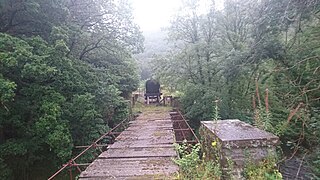
Lampeter is a town, community and electoral ward in Ceredigion, Wales, at the confluence of the Afon Dulas with the River Teifi. It is the third largest urban area in Ceredigion, after Aberystwyth and Cardigan, and has a campus of the University of Wales Trinity Saint David. At the 2011 Census, the population was 2,970. Lampeter is the smallest university town in the United Kingdom. The university adds approximately 1,000 people to the town's population during term time.

The Gwili Railway is a Welsh heritage railway, that operates a preserved standard gauge railway line from the site of Abergwili Junction in southwest Wales along a four-and-a-half-mile (7.2 km) section of the former Carmarthen to Aberystwyth line. The original railway closed in 1965, with the track being lifted in 1975.

The West Wales lines are a group of railway lines from Swansea through Carmarthenshire to Pembrokeshire, West Wales. The main part runs from Swansea to Carmarthen and Whitland, where it becomes three branches to Fishguard, Milford Haven and Pembroke Dock.

Whitland railway station serves the town of Whitland in Carmarthenshire, Wales. It is located on the West Wales Line from Swansea. To the west of the station, a branch line diverges towards Pembroke; the main line continues to Milford Haven and Fishguard Harbour. The Whitland and Cardigan Railway diverged from the Fishguard/Milford Haven line 2 miles (3.2 km) west of Whitland.

Llandeilo railway station serves the town of Llandeilo, Carmarthenshire. The station is 30+3⁄4 miles (49 km) north east of Swansea on the Heart of Wales Line.

The Teifi Valley Railway is a 2 ft narrow gauge railway occupying a section of the former standard gauge Great Western Railway line between Llandysul and Newcastle Emlyn. After the closure of the former line by British Rail in 1973, a preservation group built and periodically extended a narrow-gauge railway along the route, westwards from Henllan, eventually operating a 3 kilometres (1.9 mi) long line as a tourist attraction.

The Carmarthen–Aberystwyth line was originally a standard-gauge branch line of the Great Western Railway (GWR) in Wales, connecting Carmarthen and Aberystwyth.
The Carmarthen and Cardigan Railway was a 7 ft 1⁄4 in broad gauge railway line in Wales that was intended to connect Carmarthen on the South Wales Railway with Cardigan. In fact, it was unable to raise the necessary capital and was loss-making from the time of opening the first short section of its line in 1860, and it was in receivership for much of its life. It eventually reached Llandysul in 1864 but was not extended further during its independent existence.

Llanpumsaint is a village and community in Carmarthenshire, Wales. In the 2001 UK Census, Llanpumsaint community had a population of 595. It is not to be confused with Pumsaint, a small village some distance away on the River Cothi. The population increased in 2011 to 734, and thus the percentage of Welsh speakers declined.
The Manchester and Milford Railway was a Welsh railway company, intended to connect Manchester and the industrial areas of North West England with a deep-water port on Milford Haven, giving an alternative to the Port of Liverpool.

Bronwydd Arms railway station, originally a stop on the now closed Carmarthen to Aberystwyth Line, is the headquarters of the preserved Gwili Railway, in Wales, United Kingdom.
The Lampeter, Aberayron and New Quay Light Railway was an independent branch line railway in south west Wales. It connected Aberayron to the former Manchester and Milford Railway line at Lampeter; New Quay was never reached.

Cynwyl Elfed is a village and community in the county of Carmarthenshire, Wales. The community includes the villages of Cynwyl Elfed, Blaenycoed and Cwmduad. It is situated about 5 miles (8.0 km) north of Carmarthen and had a population of 953 in 2001, increasing to 1,044 at the 2011 Census.

Abergwili railway station served the village of Abergwili in Wales. It was the first station after Gwili Junction, the point where the line through it divided from the Carmarthen to Aberystwyth Line.

The River Gwili in Carmarthenshire, is a tributary of the River Towy, the longest river entirely in Wales. Its headwater is found east of Llanllawddog, in the Brechfa Forest. It runs west, through Llanpumsaint, to its confluence with the River Duad, just south of Cynwyl Elfed village. Here its course turns to the southeast, running through Bronwydd before joining the River Towy at Abergwili.
Llanpumpsaint was a railway station near the village of Llanpumpsaint, West Wales, serving the hamlet and the rural locale.

Conwil was a railway station near the village of Cynwyl Elfed in Carmarthenshire, Wales, serving the hamlet and the rural locale. It was once a thriving railway station, transporting both passenger traffic and locally produced goods, including wool, livestock, milk and timber.
The Great Western Railway was a railway company that was dominant in West Wales, in the United Kingdom.

Abergwili Junction railway station in the town of Abergwili, Carmarthenshire, Wales, is the southern terminus of the Gwili Railway.





















